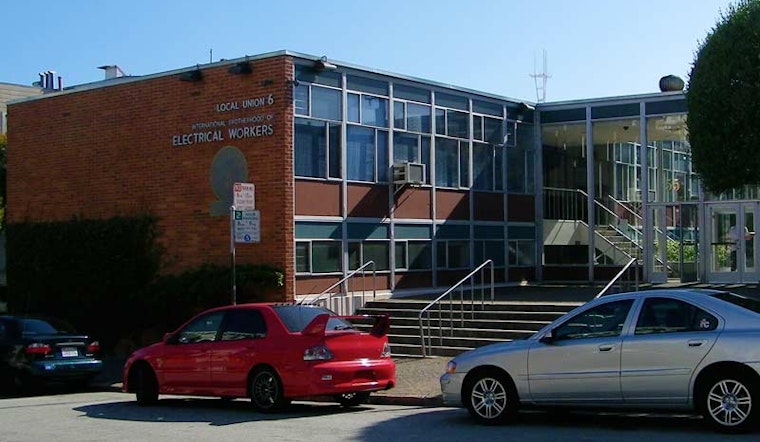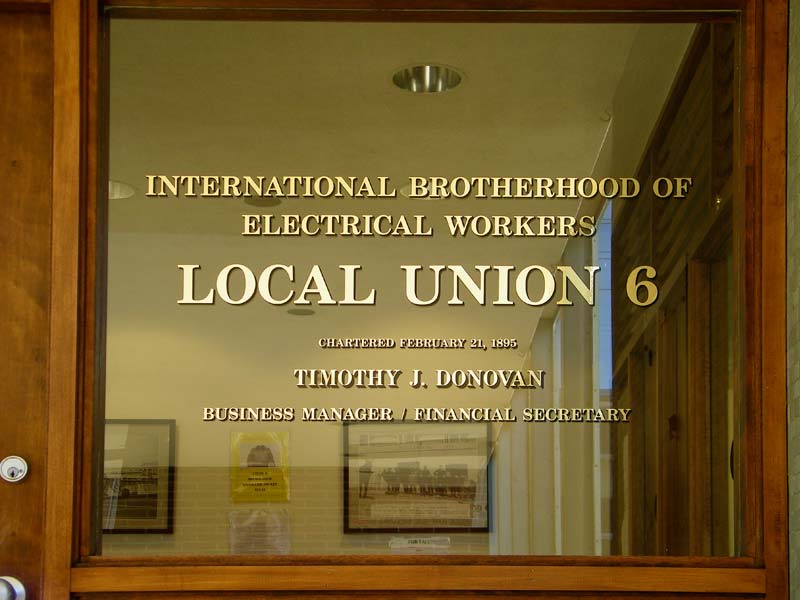
You've probably passed it a hundred times: the strange, square brick building on the corner of Fillmore and Hermann.
It's not a library, though there's a good reason you might think it is. The 1957 building was designed by architect Francis McCarthy, who was known for them.
No, 55 Fillmore Street is the headquarters of the International Brotherhood of Electrical Workers (IBEW) Local Union 6.
The building houses the administrative offices for the union's elected business manager and representatives, as well as a large meeting hall. On the second Wednesday of each month, Local 6 holds a General Membership Meeting. It's these meetings during which you've probably seen people hanging out and barbecuing in the courtyard. Union electricians undertake a five year apprenticeship program before becoming journeymen. These men and women keep Muni lines humming, the Fi-Di fired up, General Hospital wired, and the Golden Gate Bridge aglow. Local 6 also focuses on philanthropy, hosting fundraisers and contributing to Saint Anthony's Dining Hall, Glide Memorial Church, the Delancey Street Foundation, and Little Sisters of the Poor. Each April, the Local participates in a program called Rebuilding Together, in which electricians donate their time to renovate and repair homes for low-income and elderly residents, schools and nonprofits. Though solidarity with workers is a large part of the city's current identity, San Francisco wasn't always a union town. The most contentious moment in the city's relationship with labor was the West Coast Waterfront Strike of 1934, during the height of the Great Depression, when over 34,000 longshoremen walked out of work. To protest poor working conditions, hiring corruption, and low wages, ports were shut down and trade halted from San Diego to Seattle. San Francisco came to the forefront of this struggle on July 5th 1934, a day referred to as "Bloody Thursday," when employers and police tried to break waterfront picket lines. Two men were killed and hundreds injured in massive riots. By nightfall, San Francisco was a war zone. Tear gas, gunfire, and open fighting filled the streets. Armed National Guards moved in to patrol the Embarcadero. Army soldiers at the Presidio were placed on alert. Tens of thousands marched in a funeral procession down Market Street for the fallen men, culminating in a city-wide strike. For four days, San Francisco shut down. The mayor called a state of emergency. The governor was about to impose martial law when unions and employers finally reached an agreement. The strike remains one of most significant in U.S. history, and San Francisco has remained at the forefront of Organized Labor ever since. So this Labor Day, when you pass by 55 Fillmore, you can regale friends with the story of San Francisco's role in labor movement history. And the next time you ride the 22, flip on a light in your sweet Lower Haight studio, or plug in your computer at a neighborhood coffee shop, chances are you have a Local 6 electrician to thank for it.
The building houses the administrative offices for the union's elected business manager and representatives, as well as a large meeting hall. On the second Wednesday of each month, Local 6 holds a General Membership Meeting. It's these meetings during which you've probably seen people hanging out and barbecuing in the courtyard. Union electricians undertake a five year apprenticeship program before becoming journeymen. These men and women keep Muni lines humming, the Fi-Di fired up, General Hospital wired, and the Golden Gate Bridge aglow. Local 6 also focuses on philanthropy, hosting fundraisers and contributing to Saint Anthony's Dining Hall, Glide Memorial Church, the Delancey Street Foundation, and Little Sisters of the Poor. Each April, the Local participates in a program called Rebuilding Together, in which electricians donate their time to renovate and repair homes for low-income and elderly residents, schools and nonprofits. Though solidarity with workers is a large part of the city's current identity, San Francisco wasn't always a union town. The most contentious moment in the city's relationship with labor was the West Coast Waterfront Strike of 1934, during the height of the Great Depression, when over 34,000 longshoremen walked out of work. To protest poor working conditions, hiring corruption, and low wages, ports were shut down and trade halted from San Diego to Seattle. San Francisco came to the forefront of this struggle on July 5th 1934, a day referred to as "Bloody Thursday," when employers and police tried to break waterfront picket lines. Two men were killed and hundreds injured in massive riots. By nightfall, San Francisco was a war zone. Tear gas, gunfire, and open fighting filled the streets. Armed National Guards moved in to patrol the Embarcadero. Army soldiers at the Presidio were placed on alert. Tens of thousands marched in a funeral procession down Market Street for the fallen men, culminating in a city-wide strike. For four days, San Francisco shut down. The mayor called a state of emergency. The governor was about to impose martial law when unions and employers finally reached an agreement. The strike remains one of most significant in U.S. history, and San Francisco has remained at the forefront of Organized Labor ever since. So this Labor Day, when you pass by 55 Fillmore, you can regale friends with the story of San Francisco's role in labor movement history. And the next time you ride the 22, flip on a light in your sweet Lower Haight studio, or plug in your computer at a neighborhood coffee shop, chances are you have a Local 6 electrician to thank for it.











